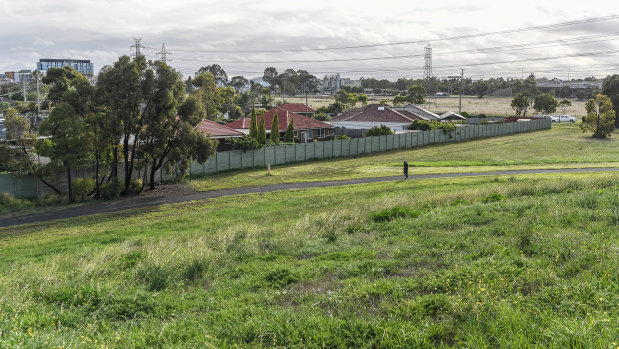This was published 4 years ago
Editorial
More light a must in dark landfill chapter
Last month's decision by Brimbank City Council to notify residents of St Albans and Albion that they were living in close proximity to and even on top of the former Sunshine Landfills might be welcomed as a step in the right direction if it wasn't so long overdue.
As The Age has reported, the council and the Environment Protection Authority have known since 2013 that residents were at risk from a volatile and inadequately contained mixture of domestic refuse and toxic and radioactive industrial waste.

The view from the old Sunshine Landfills site onto houses in Denton Avenue in St Albans.Credit: Justin McManus
But this was not the full extent of their knowledge, which goes back decades to Brimbank's predecessor council, the City of Sunshine, and to the earliest years of the EPA itself in the 1970s. It was the EPA that, at the council's appeal, overturned a Commission for Public Health ban on pouring liquid waste into the seven unlined pits in the council area. Late last year, the council was confidentially informed that it could be held legally responsible as "the polluter" and that the EPA or the state government were also in the firing line as "the entity that permitted the pollution".
To argue after such a long history of non-disclosure that the risk is no longer high, or that processes for informing the public are now in place, is unlikely to reassure residents anxious over the long-term health of their families or landowners concerned over the value of their properties. The lack of response to calls for a town hall meeting on the issue - even as one law firm is preparing to hold a public meeting with those affected, possibly with a view to a legal class action - suggests that the council is still evading proper scrutiny, its recent release of information packs for residents and its online "fact sheets" notwithstanding. It is also worth noting that the statute of limitations on claiming damages over the pollution is six years while the report into the landfills - commissioned by the council and only now coming to light - was handed to the EPA seven years ago.
The repurposing of industrial sites is a valuable way to create new accommodation in inner suburbs and is a welcome alternative to extending the urban fringe, but only if it is accompanied by transparency regarding the status of each site - transparency that seems to have been lacking at every stage until February.
Given the existence in Melbourne of several landfill and industrial sites redeveloped for residential use, compensating and relocating the residents of homes built on the Sunshine Landfills may be seen by local and state government as setting an onerous precedent.
But with new state legislation set to take effect on July 1 that will make landowners legally and financially liable for contamination on their properties, it was hugely important that the Andrews government – in response to questions from The Age – stepped in this week to pledge that none of the St Albans and Albion residents would face prosecution over the landfills legacy.
That vital first step must lead to others. It is essential that Brimbank City Council, the EPA and the state government commit to all necessary measures for thorough monitoring and remediation of this mess, which the landowners had nothing to do with making, and to guarantee that from this date information on those measures is publicly presented in a timely and straightforward way. After so much has been buried in murk, it is time for real sunshine to reach the bottom of this pit.